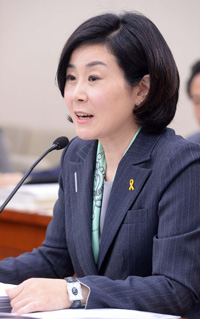- California Assembly OKs highest minimum wage in nation
- S. Korea unveils first graphic cigarette warnings
- US joins with South Korea, Japan in bid to deter North Korea
- LPGA golfer Chun In-gee finally back in action
- S. Korea won’t be top seed in final World Cup qualification round
- US men’s soccer misses 2nd straight Olympics
- US back on track in qualifying with 4-0 win over Guatemala
- High-intensity workout injuries spawn cottage industry
- CDC expands range of Zika mosquitoes into parts of Northeast
- Who knew? ‘The Walking Dead’ is helping families connect
S. Korean gov’t's new policy on multiracial families to promote openness
‘More openness toward multiracial people is next policy target’
By Kim Se-jeong
The government will put a greater focus on correcting prejudiced views of multiracial families and boosting the public’s receptivity of them, said Minister of Gender Equality and Family Kim Hee-jung in a recent interview.
Her remarks show the ministry’s policy focus shifting from the current policy of helping marriage migrants adapt to life here over the last decade.
“The policy has come a long way, but what’s more important now is for Korean society to embrace these multicultural families more heartily,” Kim said. “We will make greater efforts to raise public awareness that these families bring openness and flexibility to Korean society.”
One such effort was the revision of the Multicultural Families Support Act passed earlier this month. The new law stipulates that multiracial families receive different services depending on their income level.
A majority of immigrant wives in Korea are from other Asian countries such as China, Vietnam, Mongolia and Japan. While Koreans often regard them as lower-class citizens in need of help, many are reluctant to help them, believing that the immigrant population places a burden on their own opportunities for welfare.
One support program for marriage migrants is a home-visit service, in which Korean language instructors and social workers visit the family to teach the Korean language or give counseling to make cultural integration smoother.
“So far, all of these foreign spouses received the home-visit service regardless of income level,” the minister said. “But under the revised law, this will change and the service will be given only to those in the low-income bracket. I believe this will help people see these families as more than just recipients of social benefits.”
The revised law also makes it mandatory for teachers and heads of childcare centers and kindergartens to take action to protect children from multiracial backgrounds from discrimination. The ministry is working on more details.
Past and future
As the marriage immigrant population grew, so too did the need for effective policies.
According to the ministry, there are almost 300,000 migrant spouses in Korea, mostly women, and they are estimated to have had around 200,000 children. The ministry expects 1 million people will have multiracial families by 2020.
The government began to offer support programs for them in 2006 when the flow of marriage migrants reached its peak, with bachelors in rural areas looking for wives from other Asian countries.
The growing trend had various downsides, such as family conflicts arising from the foreign spouses’ difficulties adapting to a new culture and relationship.
The government began offering help to marriage migrants through 217 multicultural family support centers. The centers have proven effective, helping reduce such conflicts.
Marking the 10th anniversary of the government’s policy for multiracial families this year, Kim said the future policy focus for the next 10 years will be on children, especially those who join their parent in Korea later after the parent married a Korean citizen.
“These children are more vulnerable to identity crises, and it’s very critical to help them grow without major trouble,” she said.
One of the support programs is the Rainbow School, with 17 branches around the country offering information about Korea, Korean language education and academic assistance to new arrivals.
The ministry also runs a multi-language program, aiming at increasing fluency of multiracial children in Korean and the language of the immigrant parent. “We hope these children will be a bridge between Korea and the country of their parent,” the minister said.
Some 6,800 children have participated in the multi-language program, and the government will make a database of the participants’ profiles to support their further academic and job careers.


















Pingback: Bridge Language School Mongolia | certification - italianschoolflorence